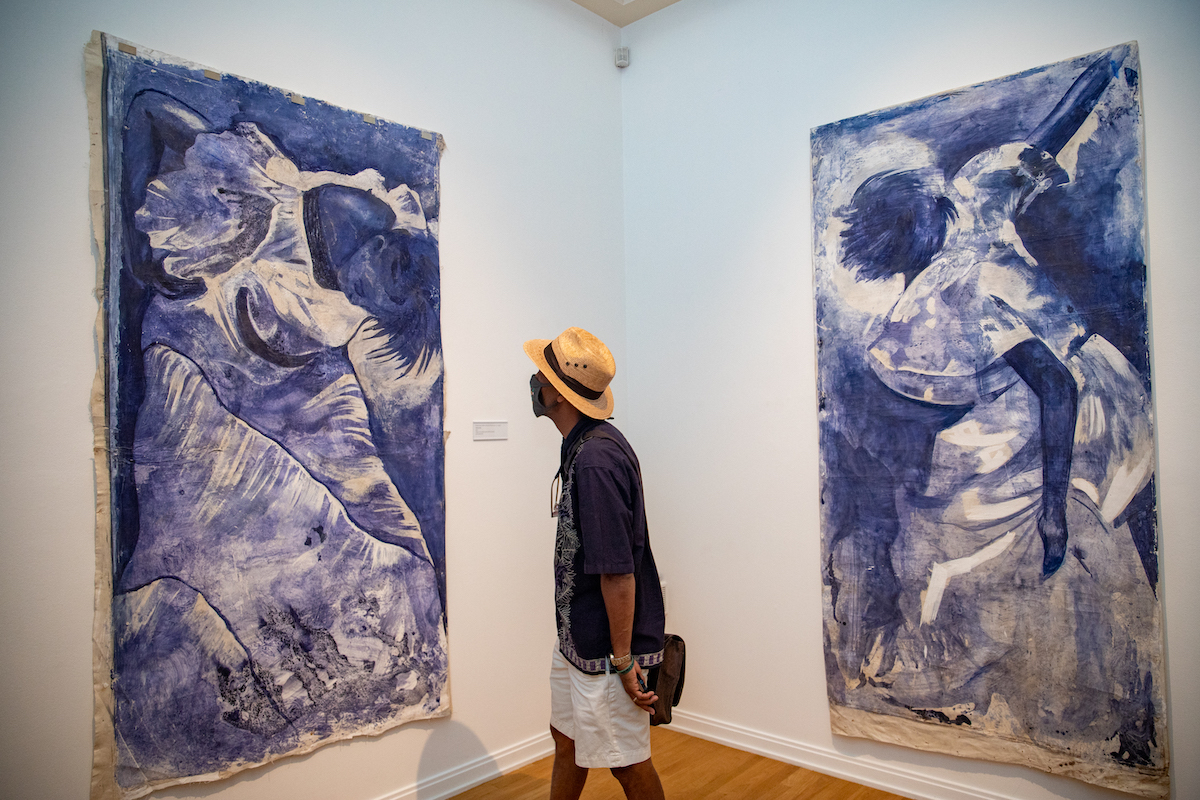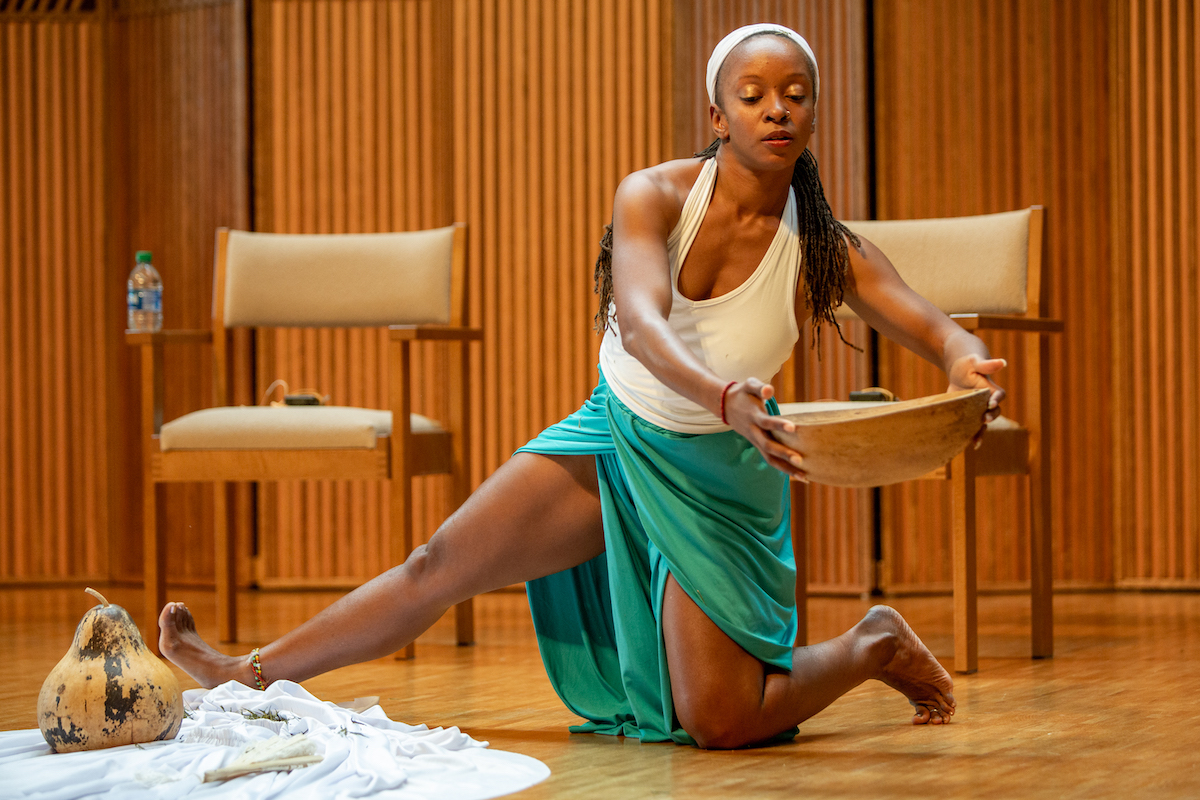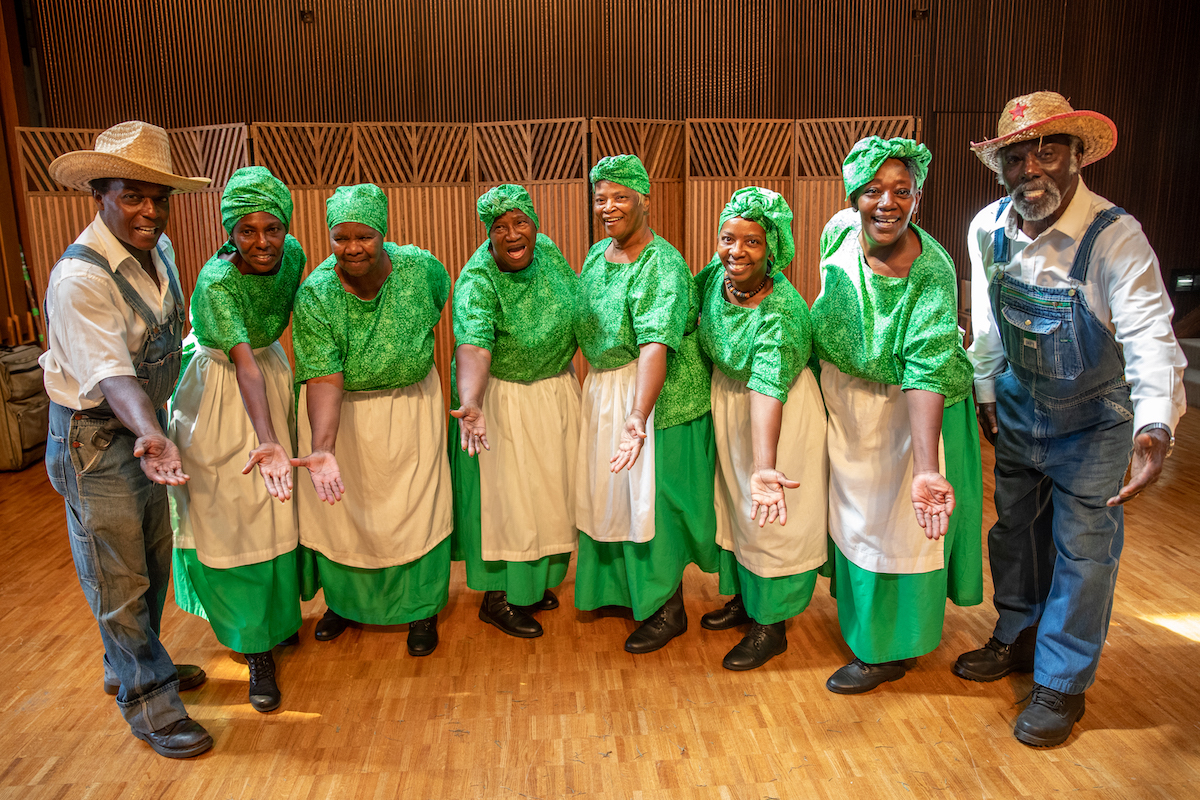When Charmaine Minniefield went to Gambia, West Africa, in early 2020, she had no idea she would be stuck there for months because of the COVID-19 pandemic. At an event hosted by Emory’s Michael C. Carlos Museum on Aug. 28, Minniefield said she went in search of the Holy Ghost.
Specifically, she went to find the source of the spiritual connection her grandmother had to people and the planet. Minniefield painted her prayers during that time, and the result is the exhibition “Indigo Prayers: A Creation Story,” which opened at the Carlos Museum in March. She used indigo for the paintings, which are on display until Sept. 11.
For centuries, Africans extracted blue dye from the indigofera tinctoria plant to add color to their clothes. Minniefield describes her use of indigo and tracing her ancestors’ steps as an act of resistance against the cultural erasure enslaved Africans experienced in the Americas. Her work with indigo ties into the Carlos Museum’s mission to explore how ancient objects connect past and present.
“When I went to The Gambia, I saw the map leading me home, like encoded messages within my identity in freedom quilts,” Minniefield says.

Conjuring a new freedom
The event on Aug. 28 began with a performance of the spiritual “Deep River” with organ by Trey Clegg 97G and vocals by Minniefield’s musical collaborator, Malesha Jessie Taylor.
Then Minniefield, who was previously the artist-in-residence at Emory’s Stuart A. Rose Manuscript, Archives and Rare Book Library, asked about 250 attendees in Cannon Chapel to invite their ancestors into the space. By saying the names of those who have gone on, they connect to their wisdom and “conjure a new freedom for a new time.”
Following the invitation, Minniefield showed a video she made from her time in Gambia exploring the Ring Shout. The Ring Shout is a call-and-response dance and song ritual where people gather in a circle and sing songs and tell stories. In the U.S., the Ring Shout was an occasion for enslaved people to worship God and sing about freedom in their own language. Minniefield found in her research that in every continent where Black people were enslaved and/or displaced, there was some version of the Ring Shout.
As the video played, Tamara Williams, associate professor of dance at the University of North Carolina, Charlotte, performed a dance ritual reminiscent of the Ring Shout. Dressed in a white leotard and turquoise pants, Williams laid her white skirt on the floor and placed a bowl and gourd there as an offering. Her work blends contemporary dance and West African dance.

Following the performance, Williams joined Minniefield and Julie B. Johnson, chair of the Spelman College dance department, to discuss “Indigo Prayers” art as activism.
Johnson asked Minniefield to speak about one of the prayers in the paintings, and Minniefield chose to talk about abundance.
“Abundance for me speaks to social justice and where I’d like to see equity and justice play out in community,” Minniefield said. “I’d like the world to acknowledge the abundance that is Africa.”
Johnson also asked about how memory lives in the body and comes out through dance. For many African American attendees, Williams’ performance resembled praise dancers at church.
“I approach Ring Shout as ancestral dance, ancestral memory,” Williams said. “When I teach, I show students what different gestures and movements represent. Once you know your ancestors, your people, you hold it sacred.”
Sankofa: To go back and get
Following the conversation, the Geechee Gullah Ring Shouters from Darien, Georgia, performed.
After Emancipation, formerly enslaved people on the coast settled in farming communities. They are known as Gullah or Geechee, and they primarily live between the sea islands of North Carolina and Northern Florida. They continued the Ring Shout as a worship service where they spread messages about salvation.
The practice is part of the foundation of the African American church. In Georgia, Sapelo Island remains a home for Gullah-Geechee people.
The Ring Shouters, led by a seventh-generation Gullah-Geechee man, Griffin Lotson, have been taking the Ring Shout around the world for more than 20 years. In Cannon Chapel, the women dressed in all green and the men wore denim coveralls. They moved counterclockwise in a circle making music with the same tools enslaved people would have had on plantations: a washboard, wooden stick, hands and feet. Lotson said that they do this to honor the ancestors who survived bondage.

The group sang “Kumbaya,“ “Amazing Grace” and “Yonder Come Day.” Between songs, they educated the audience about their language, food and culture as well as imparted wisdom.
“It’s better to be seen than viewed,” one of the Ring Shouters said. “It is better to be talked to than talked about. You have to grow up to grow old.”
Following the performance, some attendees moved over to Ackerman Hall to enjoy an ancestral feast prepared by Cleophus Hethington, a James Beard finalist for “Best Emerging Chef.” A Navy veteran, Hethington worked at Lazy Betty in Atlanta before becoming executive chef at Benne on Eagle in Asheville, North Carolina.
With food, Hethington strives to connect the African diaspora, from his Trinidadian roots to South America to West Africa. At the feast, he served plantains with fermented soybeans and a rice cracker, his take on Cuban arroz congris, or rice and black beans. It was followed by a smoked trout, similar to Jamaican callaloo and saltfish.
This fall, Hethington is returning to Atlanta with a pop-up restaurant, Ebí Chop Bar, where he will continue blending flavors from the continent with Caribbean, Latin and Southern cuisine.
The Praise House
As attendees ate, Minniefield played the music and video from her Praise House Project.
After returning from Gambia, Minniefield collaborated with Taylor, musician Salah Ananse and Flux Projects to erect a small white house with a wooden floor to replicate the Praise Houses where African Americans held Ring Shouts.
The Praise House was one of the few places where enslaved Black people could be themselves and connect with African culture.
Inside Minniefield’s Praise House, videos of Ring Shouts from around the world are projected on the walls while the original song “Rite to Freedom” plays. The Praise House was on display near the African American burial grounds at Oakland Cemetery from June 19 to July 11, 2021, in an exhibition called “Remembrance as Resistance.”
At the event, Candy Tate, assistant director at Emory Arts, announced that the Praise House Project will be coming to Emory’s campus in fall 2023. The Praise House will be erected next to Glenn Memorial Church, and there will also be an oral history component archived at the Rose Library in the name of the late Pellom McDaniels III, who was the curator of the African American collections.
For Minniefield, the project is all about finding freedom, connecting the African Diaspora across continents as well as spreading the word about all that her ancestors have given the world.
“We lifted the Praise House to honor the 872 people who were displaced [from Oakland Cemetery] to make room for white citizens,” Minniefield said. “We stand on these hallowed grounds to educate the young.”

